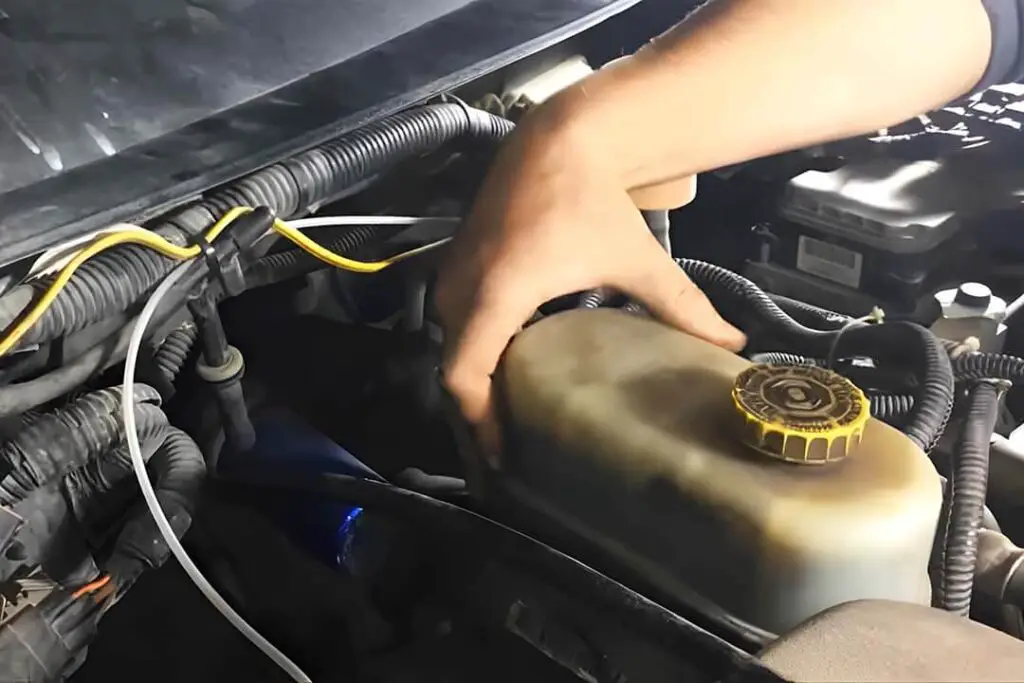The hydroboost system is a crucial part of power steering. Some Dodge truck models, such as the Dodge D150, Dodge W150, Dodge Ram 50, Dodge Ram 150, Dodge Ramcharger, etc., are equipped with this hydroboost system. Its purpose is to make steering smoother and safer by using hydraulic power to strengthen the brakes. Among Dodge truck owners, a common question often arises: “Can a Bad Hydroboost Affect Steering?” The answer is yes. If the hydroboost isn’t functioning correctly, steering can become more difficult, leading to potential safety issues.

In this article, I will discuss the effects of hydroboost malfunction, why it occurs, signs to watch for, how mechanics diagnose the issue, and the methods to fix it. So, let’s get started!
Contents
How Hydroboost Works
Hydroboost is a power brake booster that utilizes a hydraulic system to amplify the force applied to the brake pedal. The hydraulic system uses a pump to create pressure in the power steering fluid, which is then used to assist in the operation of the brake system. When the brake pedal is pressed, hydraulic pressure provides additional braking power.
The hydroboost system is typically mounted on the firewall and is connected to the power steering pump and the brake master cylinder. The system uses a power steering fluid reservoir to store the hydraulic fluid used in the hydraulic system.
When the brake pedal is pressed, a valve in the hydroboost system opens, allowing pressurized power steering fluid to enter the booster chamber. The pressurized fluid then applies force to a piston, which in turn applies pressure to the brake master cylinder, providing additional braking power.
Hydroboost works in tandem with the power steering system, which provides the hydraulic pressure needed to assist in the operation of the brake system. This provides drivers with greater control over their vehicles and enhances overall safety.
Symptoms of a Bad Hydroboost
How do I know if my hydroboost is bad? A bad hydroboost can lead to various symptoms affecting the braking and steering systems. Recognizing these symptoms early on is essential to prevent potential safety hazards. The following are some typical signs of a faulty hydroboost:
- Difficulty braking: If the hydroboost system is not functioning correctly, you may experience trouble applying the brakes. The brake pedal may feel stiff or require greater force to operate.
- Increased steering effort: A bad hydroboost can also affect the power steering system, leading to increased steering effort. You may notice that the steering wheel is harder to turn, particularly at low speeds or when parking.
- Reduced braking performance: If the hydroboost system is not functioning correctly, you may notice that your vehicle’s braking performance is reduced. This can result in longer stopping distances or less effective braking.
- Leaking fluid: A bad hydroboost can lead to leaks in the hydraulic system, which a power steering or brake fluid loss can identify.
Can a Bad Hydroboost Affect Steering? Let’s Understand!
A bad hydroboost can significantly affect the steering function, leading to potential safety hazards. Here are some ways a bad hydroboost can affect steering:
Reduced Power Steering Functionality
With the hydroboost, the driver can move the wheels with less effort, which is a fundamental function of the power steering system. Power steering may stop working if the hydroboost is broken.
As a result, maneuvering the vehicle becomes more challenging, especially during slow-speed maneuvers or when parking. This reduction in steering assistance can make the steering wheel feel heavier and less responsive, making it harder for the driver to control the vehicle effectively.
Difficulty in Turning the Steering Wheel
A malfunctioning hydroboost can make it difficult to turn the steering wheel smoothly. When trying to steer, this may present additional resistance, requiring the driver to use more power. When quick and precise steering adjustments are necessary, such as avoiding obstacles or navigating tight corners, the increased effort needed due to a bad hydroboost can hinder the driver’s ability to respond effectively.
Increased Steering Effort
When the hydroboost is not functioning correctly, the steering system loses the hydraulic assistance that helps reduce the effort needed to turn the wheels. As a result, drivers might experience a significant increase in steering effort. This heightened effort requirement can be particularly concerning for drivers with physical limitations or reduced strength, as they might struggle to control the vehicle’s steering.
Potential Safety Hazards
Ignoring or neglecting a bad hydroboost can create potential safety hazards on the road. The driver’s ability to maneuver safely and react swiftly to shifting road conditions or unforeseen obstructions may be limited by the defective steering system. This, in turn, increases the risk of accidents or collisions, as drivers might find it challenging to make precise and timely steering adjustments to avoid dangerous situations.
Causes of Hydroboost Malfunction
A malfunctioning hydroboost system can stem from various underlying factors. Here, we delve into the prevalent causes responsible for hydroboost malfunction, shedding light on each scenario:
- Fluid Leaks: Hydraulic system leaks are a prominent culprit behind hydroboost malfunction. When leaks occur, they result in a decline in fluid pressure, disrupting the hydroboost’s functionality. The potential sources of leaks encompass the power steering pump, hoses, and the hydroboost unit itself. A compromised hydraulic system due to leaks can drastically affect the overall performance of the hydroboost system.
- Faulty Seals: Seals are integral components within the hydroboost system, crucial to retaining hydraulic fluid. Over time, wear and tear can undermine the integrity of these seals, making them susceptible to damage. Such degradation can pave the way for fluid leaks, ultimately contributing to hydroboost malfunction. The gradual deterioration of seals underscores the importance of regular maintenance to ensure their efficacy.
- Failed Check Valve: A pivotal player within the hydroboost setup, the check valve regulates fluid flow. In the event of a check valve failure, the equilibrium of fluid pressure becomes disrupted, leading to a noticeable decline in the performance of the hydroboost system. The vulnerability of the check valve underlines the significance of vigilant monitoring to detect any potential issues early on.
- Faulty Power Steering Pump: Operating as the power source generating the requisite hydraulic pressure, the power steering pump bears immense importance for the hydroboost system. Should the pump falter or experience wear and tear, the hydraulic pressure necessary for hydroboost operation becomes compromised. This shortfall in fluid pressure consequentially contributes to hydroboost malfunction.
- Contamination: Intrusion of foreign particles or debris into the hydraulic system poses a significant hazard to the hydroboost unit’s integrity. This contamination can damage the hydroboost unit and accompanying components, culminating in system malfunction. A concerted effort to maintain a clean and debris-free hydraulic environment emerges as a preventive measure against contamination-related issues.

Diagnosis and Repair of a Bad Hydroboost
Addressing a malfunctioning hydroboost system involves a meticulous understanding of its intricate workings and individual components. Here’s a step-by-step breakdown of the method to diagnose and effectively address issues within a troublesome hydroboost system:
Inspect Visually
The initial step in the diagnostic process revolves around a thorough visual examination of the hydroboost system. This entails scrutinizing the system for any visible indications of problems, such as fluid leaks, compromised seals, or evident component damage. So, carefully inspect each part to identify potential sources of malfunction.
Perform a Pressure Test
This pressure test helps identify potential issues by assessing whether there’s any loss of fluid pressure within the system. By applying controlled pressure to the hydroboost system, you can gauge its ability to sustain the necessary pressure levels. If pressure loss occurs, it could indicate underlying problems that need further attention.
Analyze Fluid and Flush the Hydraulic System
This step helps uncover any dirt or unusual things in the fluid. Take a close look at the hydraulic fluid and check for things like dirt, change in color, or anything that might make the fluid not work well.
If you suspect contaminants or debris might be causing problems, consider doing a thorough hydraulic system flush. This process involves cleaning the system to remove any foreign particles affecting its performance. Flushing the system helps bring back its cleanliness and efficiency, and you can do it yourself with the right tools and steps.
Replace Faulty Components
Once you’ve gathered insights from the earlier steps, determine if specific components within the hydroboost system need replacement. This may involve changing seals, the check valve, or the power steering pump. This hands-on approach allows you to effectively address identified issues and restore the hydroboost system’s functionality.
Read More:
- 3 Common 3.9 Dodge Engine Problems You Need to Know About [Fixed]
- Troubleshoot Battery Saver Mode Dodge Charger with this Expert Guide
Conclusion
A bad hydroboost can significantly impact a vehicle’s steering function, leading to potential safety hazards on the road. Suppose you notice any symptoms of hydroboost malfunction. In that case, it is essential to have your car inspected by a qualified mechanic to prevent further damage to the system and ensure the safety of your vehicle on the road.
If you have any further queries regarding “Can a bad hydroboost affect steering?”. Please feel free to comment below! Thank you!
